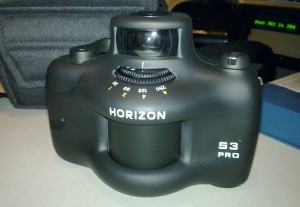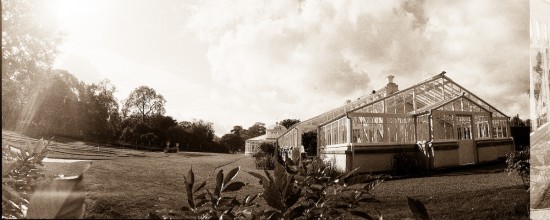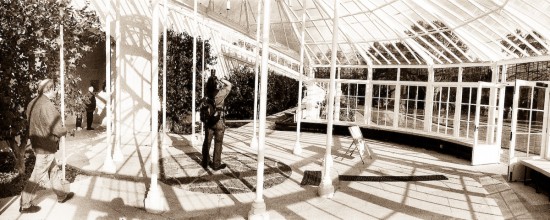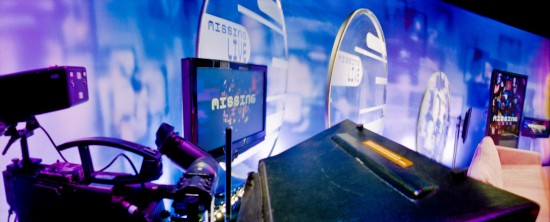 After a long journey from the Zenit factory in Krasnogorsk near Moscow via Atlanta and Miami, my brand new Horizon S3 Pro camera has arrived here in London (with Chinese newspapers as packaging material). What an international adventure!
After a long journey from the Zenit factory in Krasnogorsk near Moscow via Atlanta and Miami, my brand new Horizon S3 Pro camera has arrived here in London (with Chinese newspapers as packaging material). What an international adventure!
This is a slit-exposure camera like the Widelux and Noblex – neither of which I could afford. I always wanted one of these cameras and finally bought one on eBay.
I have used this beauty for nearly a year now and can give you my honest opinion about it:
The Horizon S3 sucks. Period.
Let me tell you why I think that, but let me also show you some impressive results this camera can deliver – if it doesn’t eat the film before you get a chance to develop it.

When I was looking for a wide swing lens camera in early 2010, I really wanted a Japanese Widelux, probably because Jeff Bridges uses it. He creates amazing behind the scenes shots with a Widelux and I loved the look ever since I saw his output many years ago: aspect ratio, perspectives, subject matter. It’s partly what draws me to Peter Lik’s 617 work as well.
But since the Widelux factory has gone out of business nearly 20 years ago, and considering the hefty price tag of nearly £1000 for a used model (not to mention the superior features of the Horizon S3) the Russian model won hands down.
Let’s have a look at what my new Horizon can do for me 😉

History
Slit Exposure photography is not a new concept. In fact, according to the Lomography site, the development of the Horizon camera goes back to 1948 when the Russians designed a panoramic camera to trace artillery fire. With 120 degrees of vision, both the bullet being fired and a target being hit could be shown on the same negative. That’s a very artistic idea I have to say!
Some of my colleagues remember old group shots from school being taken with these kinds of cameras. And of course, there’s always the kid in the class who figures s/he can outrun the shutter and be on the same picture twice. Those were the days, ey?
The first Horizon was introduced as a “civilian” (non-bullet tracking) device in 1989 and was designed by P. A. Tikhomirov.
Other manufacturers of slit exposure cameras are Widelux from Japan and Noblex from Germany. The latter uses a silent motor to drive the shutter, whereas the Widelux and Horizon are fully mechanical using spring loaded mechanisms – no batteries needed.

What’s in the Box
- Horizon S3 Pro camera (nice!)
- optional hand grip
- nylon carrying case with shoulder strap and front pocket (lovely!)
- shoulder strap for camera (a bit too short)
- 3x speciality filters (ND, UV and yellow/green)
- instruction manual (in Russian, with English front cover)
- certificate with hand written date and serial number (cute!)
Can’t find an English manual for this camera? Have a look here 😉 Remember when cameras used to come with a carrying bag and accessories? Zenit still have that mindset of “give a customer value for money” – and I for one greatly appreciate this.
I’ve done a lot of research on prices, and if you’re interested, avoid Lomography’s way too steep tag of £416 for their Horizon Perfekt model. Instead, have a look on eBay for a seller named moscowphoto. Special thanks go to him for a super quick transaction, free shipping and brilliant packaging. Not to mentioin superb after sales service – thanks Mike 😉

Features
The first thing that struck me about this camera is the super robust built. It’s a heavy solid piece of professional kit, not a plastic toy camera – far from it. It looks out of this world and really unusual. It’s like a magic device you want to keep looking at. The lens hides behind a swivel, the vewfinder is wider than anything you’ve ever seen and the matte black finish reminds me of The Monolith from 2001.
thank you very much for your informations about the horizon s3 pro…..
i just bought one and she ate the first two films! i was very surprised, because i was really not a beginner in loading films. i already had a horizon 202 as travelcam. i work only outside and in good light conditions or with tripod. i use only fuji velvia and have really great results from over 12 countries in the world. but anyway.
with the instruction movie on your website i could solve the problem. one thing is really important: after pushing the small button underneath the camera you must rewind until the end of the film is moving a little bit. the the film is exact in the right position and it will not be destroid….. (sorry, but english is not my mothertongue!)
best
christian
Thanks Christian,
I’ll give that a try. At the moment I’ve narrowed it down to the brand of film that works better in this camera than others: Fuji and Ilford seem to be eaten, whereas Kodak seems to work fine (in black and white that is). I mainly shoot handheld black and white and I’m loving the results – it’s just so super disappointing that I can’t rely on this camera properly.
Kodak VC seems OK, have had fun with Velvia, but not sure I can blame the film for that. Loading takes learning.
Have you had any issues of banding in your photos? And what do you do about scanning them? The lab I use only has a mask for X-Pan which doesn’t work.
Hi Steven,
I’ve had no banding issues in my pictures, however I have heard that the Widelux produces this problem when the swing mechanics are a bit dirty and hence don’t swing smooth anymore.
I scan my own film, it would be too expensive for me to have a lab do this (plus like you say they can’t do it). Get a cheap Epson scanner – any flatbed that scans negatives will do. I’m using the V750 but it’s at the top end of the range, however it comes with great scanning software (Silverfast) and a wet scanning mount. You can use the included 35mm scannig mask or invest into a Lomography DigitaLiza to hold your negs.
The XPan negative size is 24x65mm, and the Horizon produces 24x58mm – so that should work fine in theory, but if your lab have an automation in place then it may get confused. When you scan yourself you’re in complete control over that process. Depends on how much you’re shooting I guess.
The film ripping problem is definitely related to the film material: Colour materials seem to work fine, classic b/w films apart from Kodak have a problem – at least in my cameras (I’m on my second one with identical behaviour).
Thanks for your email.
I’ve bought one of the Lomo film holders that you recommend on your site and will be interested to see how that works on my scanner. The labs seem to have an automatic frame advancer on their machinery and the 6mm or so difference is a problem. My favourite lab is still not open since the 22 February earthquake as the 18 story building next to them has been condemned as being in risk of spontaneous self demolition in an aftershock (of which there are several daily).
My Horizon is fairly new and I had a little banding on some early films, but I have bought a better light meter since and will see if that improves things.
I have not had the problem that you experience with it damaging film since I had the camera repaired. When I got the camera, it would not advance film properly and tore sprockets, etc. I had it repaired locally (with funding from Rugift, who supplied the camera) and it has worked well since. The camera repairer, was a different story. He asked me to never ever bring it back!!
I use mostly out of date film when I am playing, and Kodak VC when I am serious. The out of date film is Fuji, Agfa, whatever is around and cheap. No problems with anything, so far. Just have to work out how many frames are possible, deduct one and make sure that the journal shows the maximum number recommended. I surprised myself by being able to load it one handed at the weekend, sheltering it from rain with the other hand.
It really is the most vexing camera I have ever owned and I have threatened it with sale a number of times, but never got as far as listing it, because once in every film, it creates a beautifully coloured, sharp random result.
Looking forward to trying the scanner.
Steve
I’ve been shooting on the Horizon s3 pro, honestly, any film snapping issues are from not holding down the rewind button. Usually, it takes two good tugs and it’s snapped. But if I remember the rewind button, no problems what so ever. It’s a beautiful camera.
Hi.
I picked up a used Horizon Perfekt and a Widepan Pro II. And then I picked up a (vintage Hansa mechanical self timer). **Problem is** No matter how much I fool around with the Hansa the needle that’s supposed to trigger the shutter is way too short for the Perfekt. Advice anyone? And. When I look at all the mechanical self timers on eBay, it looks like the needle length is generally the same. Hmm. Basically that’s it. How are people using a self timer on a Horizon camera? Thanx.